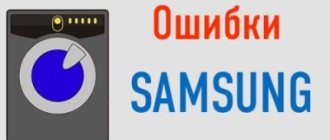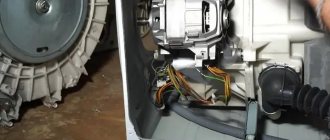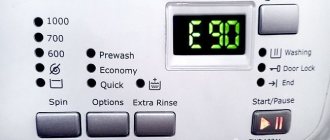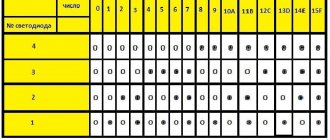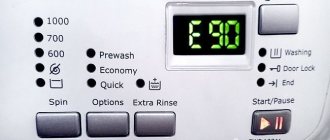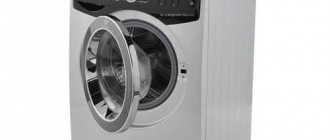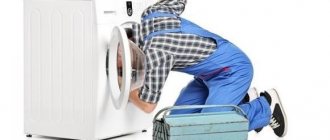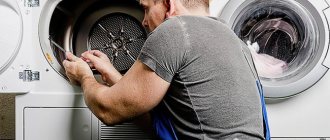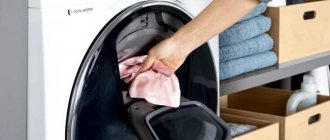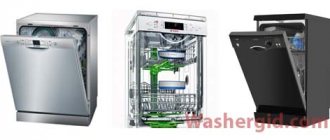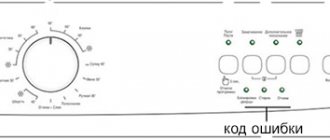Samsung has established itself as a manufacturer of reliable and high-quality household appliances, including washing machines. An automatic machine is an irreplaceable assistant, so its breakdown is a tragedy for any housewife. It’s good that most modern models, for example, Samsung WF-F861, are equipped with a special display, with which you can figure out the cause of the malfunction without calling a technician.
In case of various problems, special fault codes are displayed on the display of the washing machine.
Modern washing machines are designed in such a way that any deviation from normal operation can be recognized by a special code displayed on the display. This coding greatly simplifies the task for both the repair specialist and the owners of household appliances. Knowing the cause of the malfunction, some errors in the operation of the washing machine can be eliminated quickly and without special training.
For owners of older models without a display, for example, Samsung S821, S852, S1021, it is more difficult to understand faults - errors in them are indicated by blinking of various indicators.
Of course, error codes do not always accurately indicate the cause of unit failure, but they allow you to determine in which system the failure occurred and check the possible causes of the failure.
The photo shows a fragment of the operating instructions for the Samsung WF8590NMW9 Diamond washing machine with error code designations and methods for eliminating them
In this article we will look at error codes for a Samsung washing machine. Please note that for models of household appliances produced by other companies, the codes may differ. Error codes on the display can be combined into groups depending on the types of failure.
If a malfunction occurs, manufacturers recommend referring to the operating instructions for the washing machine. There you can also find all information error codes and their decoding.
If the instructions for the equipment are irretrievably lost, they can be found on the Internet. For example, error codes for the Samsung 6kg WF8590NMW9 Diamond washing machine can be found in its instruction manual.
Common Mistakes
Errors in the water level sensor (pressostat)
For different Samsung washing machine models, the error codes indicating the same problem may vary. For example, errors associated with a malfunction of the water level sensor (pressostat) for the oldest models will be indicated by code 1EE7 , for more modern models, for example, “Diamond”, “Eco Bubble” - E7 , 1C , 1E . If you have a Samsung washing machine made in the USA, then error 1E will be indicated as error LE .
If the display shows codes E7, 1C, 1E , you need to check the serviceability of the wiring and pressure switch hose
The pressure switch in the washing machine detects the water level and sends a corresponding signal to the control module. Errors associated with its malfunction include the loss of such a connection or incorrect operation of the element itself. You need to look for the causes of the error in the following:
- kink, breakage or other damage to the pressure switch tube;
- breakdown of relays, contacts or other electronic parts of the pressure switch;
- failure of the entire sensor;
- malfunction in the washing machine control module.
E1 is displayed, the washing machine usually automatically turns on the forced drain of water after 3 minutes.
You can eliminate possible causes of malfunctions as follows:
- first of all, it is necessary to inspect the sensor - it may be enough to simply clean the contacts, connect the tube or remove dirt from it if it is clogged;
- If it turns out that the pressure switch is faulty, it needs to be replaced.
Motor tachometer errors
Another important element of the washing machine is the tachometer (tachogenerator), which controls the rotation frequency of the drum. If it malfunctions, the number of revolutions does not correspond to the specified washing mode, and the machine may be damaged as a result of excessive rotation. The opposite situation is also possible - irregularities when loading the machine or foreign objects can block the operation of the device.
The tachometer controls the rotation speed of the electric motor.
In modern Samsung models, tachometer errors are indicated by codes 3E ( 3C4, 3C3, 3C2, 3C1, 3C, 3E4, 3E3, 3E2, 3E1 ), in older ones - EA , EB , 8E .
The most common reasons for these errors appearing on the washing machine display are as follows:
- placing more laundry in the washing machine drum than specified in the operating instructions;
- foreign objects entering the electric motor;
- malfunctions in the wiring or control module of the washing machine;
- failure of the tachometer or engine.
To eliminate possible malfunctions, the first step is to completely unload all the laundry from the washing machine. If malfunctions were associated with overload, then after turning the machine on and off, the error should disappear. More serious problems related to wiring, sensor or motor faults will be much more difficult to fix on your own. If you are confident in your abilities, check the engine for foreign objects and remove them, inspect the wiring and contacts.
Water supply problems
In this section we will talk about problems associated with insufficient or excessive water supply and improper heating.
Errors caused by such problems are indicated by codes E1, 4C2, 4C, 4E2, 4E and 4E1 .
There may be several reasons for improper water flow:
- the water supply hose is clogged, kinked or damaged;
- water supply valve clogged;
- turning off the water supply in an apartment or house;
- connection to the washing machine is not cold, but hot water.
If there are problems with the water supply, first of all you need to check the serviceability of the corresponding hose
To eliminate violations, you need to:
- Check if there is cold water in the taps and if the water supply to the washing machine is not cut off.
- Check the water supply hose to the machine: unscrew it and make sure that it is not clogged, damaged or kinked.
- Make sure that the machine is connected to cold water and not hot.
- Inspect the temperature sensor, as well as the place where the hose is connected to the powder compartment (blockages also often form in this place).
Washing machine hatch errors
If the washing machine door refuses to close or open, it is usually noticeable without prompting on the display. Errors associated with hatch damage are displayed on the screen with codes ED , DC2 , DC1 , DC , dE2 , dE1 , dE .
The hatch may break for the following reasons:
- a locked car door was opened with force and the lock was broken;
- foreign objects or debris have fallen into the grooves closing the hatch;
- there was a failure in the control module of the washing machine;
- the hatch has become skewed or deformed during operation of the machine;
- The wash was started with the hatch not hermetically closed.
If you haven't closed the car door tightly or clothes are caught in it, the problem is easy to fix: open the door, put things in the drum and close the hatch tightly until it clicks. Sometimes, in order to “remove” the error, you need to turn off and turn on the machine, and then start the wash.
Repairing the washing machine door lock is best left to professionals.
With a door that cannot be opened, the situation is more complicated: it is better not to fix such a breakdown yourself, but to contact a repairman. A malfunction in the control module can sometimes be resolved by turning off and then turning on the washing machine.
Water leak
Water leak error codes can appear on the display either when there is a real loss of water or when the sensor is broken and transmits an incorrect signal to the control module. Information codes for this error are E9, LC, LE1 and LE.
The causes of the malfunction can be very different:
- poor connection of the drain hose to the sewer pipe;
- breakdown of the water leakage sensor;
- leakage in the tank, hoses or seals;
- pump malfunction;
- excessive foaming;
- low location of the water drain hose.
Before you begin inspecting the washing machine, be sure to disconnect it from the power supply. Then check the integrity of the hoses, seals, filter and their attachment points. If you are unable to identify the problem yourself, it is better to contact a specialist.
Error 5d, 5ud , error Sud , as well as SD , SUdS , are associated with excessive foam formation. The reasons for such a malfunction in the operation of the unit may be the following:
- incorrect choice of washing powder or its overdose;
- poor quality of detergent used.
If you notice foam flowing from the washing machine, you urgently need to unplug it, remove all items from the drum, rinse the powder compartment, the filter and the drum itself.
If you use too much powder when washing, foam will flow out of the machine.
Imbalance Errors
E4 , UB or UE appear on the display of the washing machine , this means that there is an imbalance in the washing machine.
The reasons for this phenomenon are:
- uneven distribution of laundry when loading into the machine drum;
- the volume of laundry in the drum is too large or too small;
- imbalance of the washing unit.
This error does not require calling a technician and can be resolved independently. It is necessary to evenly distribute the laundry inside the drum and avoid overloading the washing machine. Manufacturers do not recommend loading the drum completely, either in terms of volume or weight of laundry.
In the instructions for each individual washing machine model you can find recommendations on how to balance the washing machine itself. You can do this yourself without calling a specialist.
Heating element errors
Another important element of the washing machine is the heating element (tubular electric heater), which heats the washing water to the desired temperature. If there are errors in its operation, codes E6, E5, HC2, HC1, HC, H2, H1, HE3, HE2, HE1 and HE .
The causes of heating element failure are often increased water hardness and lime deposits. When the heating element is covered with a thick layer of limestone, it stops heating the water and overheats itself, and then fails. You can prevent an unpleasant situation if you use special water softeners and periodically clean the washing machine, for example, using citric acid. (How to do this correctly, read this article.)
The heating element of a washing machine often fails due to the formation of limescale on its tubes
Other causes of heating element failure may be related to:
- problems with electrical wiring of household appliances;
- temperature sensor malfunction.
It is not recommended to independently repair malfunctions associated with heating element breakdowns. The only thing you can do is check whether the washing machine is connected to the network correctly.
Vibration sensor malfunctions
If the vibration sensor does not work correctly or does not send a signal to the washing machine control module at all, codes 8C1, 8C, 8E or 8E1 .
In this case, you can independently inspect the sensor and check the integrity of the electrical wiring connecting it to the control module. If the device is faulty, it must be replaced.
Power supply problems
If the voltage in the electrical network does not meet the parameters necessary for the correct operation of the washing machine, codes 9C , 9E2 , E91 or UC .
The reasons for malfunctions may be different:
- power surges;
- lack of electricity in the network;
- incorrect connection of the washing unit to the network;
- voltage readings do not correspond to the parameters of the device.
Usually, the appearance of the above codes does not require intervention in the operation of the machine - you just need to wait until the power supply stabilizes. To protect the device from power surges, you can connect a stabilizer.
The machine takes in too much water
Excess water collected in the washing tank is reflected on the display with codes E3, 0C, 0F or 0E . The reasons may be:
- errors in connecting the drain hose;
- faulty water drain valve;
- water level sensor failure.
You can remove excess water by turning off the machine, placing the drain hose in the bathtub and running the wash again.
Strengths and weaknesses of Samsung washing equipment
Samsung washing equipment is deservedly popular. For example, the new Diamond series, with a load of 5 and 6 kg, has unique useful innovations, including a small cell drum, Aqua Stop and Volt Control systems. Bubble washing technology - Eco Bubble - allows you to wash your laundry more efficiently.
Models such as Bio Compact S821 , Sensor Compact S803 J , WF- R1061 and WF- F861 have received high marks from Russians, as they have been serving their owners well for more than 10 years and are highly reliable.
Breakdowns of Samsung washing machines often occur due to violations of operating rules. In addition, some details are problematic , which include:
- drive belts;
- heating elements (hereinafter also referred to as heating elements);
- drain pumps (pumps);
- drain pipes and hoses;
- fill valves.
Heating elements fail due to too hard water, which forms scale. Poor quality of tap water and improper operation lead to blockages and breakdowns in drainage and water intake systems. These are the data from long-term statistics of leading service centers. But electronics are the strong point of Samsung SM and rarely require repairs.
Table with information codes (error codes)
In the table below, we have listed the main error codes for a Samsung washing machine, a brief description of possible problems and the reasons for their occurrence.
| Error code | Problem | Causes |
| E7 | Problems with the water level sensor | Damage to the water level sensor or its wiring, malfunction of the control module |
| 1C | ||
| 1E | ||
| L.E. | ||
| 3E | Malfunctions of the tachometer of the electric motor or the motor itself | Malfunction of the motor or tachometer, foreign objects entering the motor; overloading the washing machine with laundry |
| 3C | ||
| E.A. | ||
| E1 | No water supplied | Broken water supply hose, incorrect connection of the hose to the pipe, lack of water in the house |
| 4C2 | ||
| 4C | ||
| 4E2 | ||
| 4E | ||
| 4E1 | ||
| 5E | Water does not drain | Hose malfunctions, blockages in the hose or sewer, incorrect connection of the machine to the sewer |
| 5C | ||
| E2 | ||
| ED | Sunroof malfunction (does not open or close) | The hatch is skewed, the lock is broken, foreign objects get into the hatch or lock, control module errors |
| DC2 | ||
| DC1 | ||
| DC | ||
| dE2 | ||
| dE1 | ||
| dE | ||
| E9 | Water leak | Cracks in the tank, faulty drain hose or its position is too low; incorrect connection of the hose to the sewer |
| L.C. | ||
| LE1 | ||
| L.E. | ||
| 5d | Excess foam | Use of low-quality powder, excess detergent |
| 5ud | ||
| Sud | ||
| SD | ||
| SUdS | ||
| E4 | Imbalance Errors | There is too much or too little laundry in the machine or it is not distributed correctly; the device is not balanced |
| UB | ||
| UE | ||
| E6 | Heating element errors | Faulty heating element, incorrect connection to the electrical network |
| E5 | ||
| HC2 | ||
| HC1 | ||
| HC | ||
| H2 | ||
| H1 | ||
| HE3 | ||
| HE2 | ||
| HE1 | ||
| HE | ||
| 8C1 | Vibration sensor malfunctions | Damage to the sensor or its wiring |
| 8C | ||
| 8E | ||
| 8E1 | ||
| 9C | Power supply problems | The voltage level in the network does not match the needs of the washing machine; no voltage in the network |
| 9E2 | ||
| E91 | ||
| U.C. | ||
| E3 | Too much water | Incorrect connection of the machine to the sewer, broken water drain valve |
| 0C | ||
| 0F | ||
| 0E |
